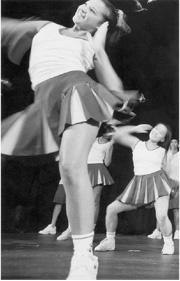STRIP CITY: A STRIPPER’S FAREWELL JOURNEY ACROSS AMERICA
by Lily Burana (Talk Miramax Books, $23.95) University Book Store, 4326 University Way N.E., 634-3400 7 p.m. Wed., Oct. 10; Bailey-Coy Books, 414 Broadway E., 323-8842, 7 p.m. Thurs., Oct. 11
LAP DANCING, pole techniques, costuming, and music selection are just some of the skills promised by the Pure Talent School in Florida, which offers a five-day crash course for women who want to become dynamite strippers. Writer Lily Burana enrolls; she hopes to look like a seasoned pro. She admits she wasn’t much of a seductress the first time round, when she danced in Times Square in the late ’80s after dropping out of high school.
Burana, who defied statistics and eventually became a magazine writer, decided to return to stripping for one epic year. Strip City is the record of her travels to topless and nude clubs across the country. One motive for the journey is her recent engagement; this is her final solo adventure before settling into domestic routine. The bigger impetus, however, is her wish for closure. “Like veterans compelled to revisit a battle scene,” Burana feels compelled to examine her conflicted past.
Stripping, Burana says, is like a drug. For every high, there’s a comedown. In one moment, she feels sexy and impervious while romping around the stage in playful outfits; in another, she’s an aged woman posing as a girl. While she’s fiercely defensive of stripping, especially in front of an older sister who’s a Presbyterian minister, she recognizes that the harsher aspects of the industry have done their damage. Like any profession, dancing becomes a measure of self-worth, based on how much money she makes off random men waving their dollar bills. The take-home pay is cut by exploitative club owners who customarily charge dancers up to $300 per shift. The pitfalls are enough to make her question, “Am I a sexually sophisticated feminist warrior woman . . . or just another coasting ‘ho?” In the end, it’s her fianc頷ho reassures her that she’s much more than her job.
THE BREEZIER sections of the book involve interviews with veteran dancers who genuinely love their work but whose expertise may render them freakish. One woman can light her nipples on fire; another, a burlesque legend known as Tempest Storm, still packs the house at the chipper age of 72. Still enjoyable are Burana’s numerous preparations to become everyman’s fantasy. Dolly Parton once said it takes a lot of money to look cheap. Apparently, it also takes a lot of money to look naked, as Burana spends over $900 one afternoon on stripping gear—backless minidresses, leopard-print sandals, iridescent booty shorts, and the like.
With so many shopping trips and visits to tanning and beauty salons detailed, Strip City reads a bit like Strip Mall City. In a less costly spree at Wal-Mart, Burana loads up on Slim Fast meal bars, skirting loud kids and towering displays of sandwich cookies. Such specifics would seem extraneous if they didn’t underscore the inherent contradictions of stripping. As Burana rediscovers during her tour of the country’s topless bars, the industry’s surface glamour is invariably twinned with seedy realities, as are the thrill of feminine power and the humiliation of “begging” with one’s body.
Burana’s anecdotes are a little too familiar. She’s a talented storyteller, but her prose here isn’t nearly as sharp as in her work for New York and Salon. While Strip City may be an important personal project for the author, the book doesn’t reveal much that isn’t already obvious to anyone who’s stepped inside a strip joint.






